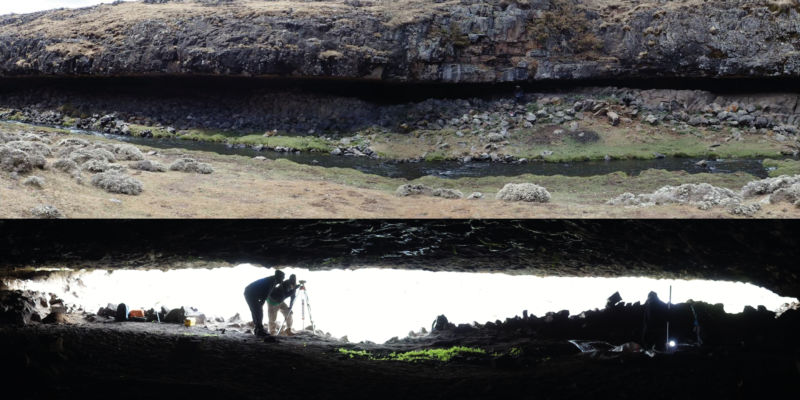
Life at high elevations is tough, as the lower air pressure makes it hard for the body to get enough oxygen into the bloodstream. The weather is often cold but can shift without warning. And if you want to stay very long, you have to find food in an environment where plants and animals are relatively scarce. But around 47,000 years ago, people apparently lived (at least for a while) in a rock shelter 3,469 meters (11,400 feet) above sea level in Ethiopia’s Bale Mountains.
Archaeologists found hundreds of stone tools, thousands of discarded animal bones, and ancient hearths buried in layers of sediment on the floor of Fincha Habera rock shelter. According to radiocarbon dates from charcoal and burnt bone, the first people lived there between 47,000 and 31,000 years ago. The site is one of the earliest examples we have of people living at high elevations, instead of just venturing up to collect stone or forage.
Until recently, paleoanthropologists thought that people didn’t tackle the challenges of life at high elevations—in places like the Tibetan Plateau, the Peruvian Altiplano, or the Ethiopian mountains—until pretty late in our species’ world takeover. High places are difficult, so it made sense that people would have put the effort off as long as possible, until they found a really compelling reason. This find, along with others, suggests ancient people (and likely our hominin cousins) were much more capable than we’ve sometimes realized.
Giant mole rat: It’s what’s for dinner
Around the time of the Last Glacial Maximum in east Africa, the people who left their tools and meals behind in Fincha Habera would have lived a few hundred meters below the fluctuating edge of a glacier. Life at Fincha Habera would have been cold but not totally inhospitable. Glacial melt would have provided fresh water to drink, and obsidian outcrops on a ridge a few hundred meters higher up contained ample material for stone tools. Discarded bones on the shelter floor suggest that people here ate roasted mole rat—and sometimes had to compete with hyenas for it.
About 94 percent of the discarded animal bones at the site came from the large rodents—burn marks at the extremities suggest that people preferred roasting them whole. The few other bones in the cave came from various bovid species, a fox, and even some baboons (which forage in the high grasslands of the Ethiopian plateau and sleep on cliffside ledges).
Giant mole rats don’t look like the most appealing game in the world—picture a naked mole rat, then give it a coat of tawny fur and make it about three times bigger (suddenly Meatless Mondays start sounding like a great idea). But don’t knock it until you’ve tried it, because giant mole rats are actually a great food source, especially if you’re trying to make a living where plants and game are scarce and the thin air means you have to use every breath wisely.
Giant mole rats dig tunnels between patches of tasty plants, but unlike their uncouth naked cousins, they pop to their surface to eat, which makes them pretty easy to trap, at least compared to the effort of hunting larger, fleeter game like mountain goats. In more technical terms, they offer hunters more calories for less physical effort.
-
Middle Stone Age hunter-gatherers called Fincha Habera rock shelter home 47,000 years ago, but archaeologists can't yet be sure how long they stayed—or why.Gotz Ossendorf
-
People at Fincha Habera made stone tools from obsidian from an outcrop on the ridge in the center of the photo.Gotz Ossendorf
-
Archaeologists excavated layers of sediment deposited by mountain streams.Gotz Ossendorf
-
This obsidian point from Fincha Habera has clear traces of wear from a lifetime of use. The stone came from an outcrop less than 10km away from the shelter.Gotz Ossendorf
The artifacts tell us that Fincha Habera was a place people lived, at least temporarily; they cooked and ate meals here, and they made and used stone tools. Artifacts span the whole lifetime of the tool, from various stages of knapping to well-used and retouched tools. People weren’t just collecting obsidian from the nearby outcrops and hiking back down to the lowlands, and they weren’t just bringing pre-made tools with them to hunt.
And there’s more subtle evidence, like chemicals called 5beta-stanols—the lingering chemical traces of ancient fecal matter. Archaeologist Götz Ossendorf and his colleagues describe the chemical evidence as representing “a massive presence of human feces.”
But we don’t know why people moved into this challenging environment in the first place, how long they stayed, or how separate their lives were from those of people down in the lowlands. Nothing at the site tells archaeologists if the people who lived here did so year-round for years at a time or if they came only seasonally. Seasonal migrations and permanent residency are two very different ways of life, which require different levels of adaptation, so they suggest different phases of human expansion into difficult environments.
In Tibet, for instance, archaeological evidence suggests that hunter-gatherers started seasonally visiting the northeastern margins of the high Tibetan plateau between 15,000 and 13,000 years ago but didn't start living there permanently until 12,000 to 7,400 years ago. If we knew which phase of that process was happening in Ethiopia at Fincha Habera 47,000 years ago, we'd know more about the overall story of people moving into the world's high places.
Science, 2019. DOI: 10.1126/science.aaw8942, 10.1126/science.aay2334. (About DOIs).
reader comments
48